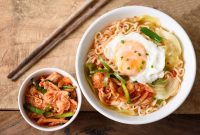Ramen noodles: Japan’s “folk dish” conquers the world and returns to its homeland in China
Of course, the historical homeland of the dish that the Japanese call ramen is China. The word is written in two Chinese characters – (literally “stretched noodles”) and describes the method of production: wheat flour dough is repeatedly stretched until infinitely long noodles are obtained.
In China, there are also different types of ramen, for example, Lanzhou-style ramen is always prepared with beef broth. But in comparison with the abundant variety of types of both the noodles themselves and the broth, dressings and seasonings from which this dish is prepared in Japan, the Chinese assortment looks much more modest. At the same time, along with curry sauce.
or karee, as the Japanese call it in their own way, ramen won the love of the broad masses of the Japanese population, becoming a truly “folk dish”. It continues to evolve, ways are being found to make the taste even richer and richer, more and more varieties appear, Japanese Ramen penetrates the countries of the West. Moreover, in our time it is gaining popularity, returning in this modified guise to its historical homeland, China.
An amazing fact: there are 35,000 specialty restaurants in Japan offering ramen!
” – these words can often be heard from the Japanese in China. Indeed, ramen in Japan is exceptionally tasty. This dish is firmly rooted in the life of the Japanese, becoming ubiquitous and everyday, and chefs have perfected the methods of its preparation and selected the best ingredients and seasonings, competing for the sympathy of customers.
According to the Japanese Prefectural Character Rankings and Statistics website, in 2013, there were 35,330 such restaurants and restaurants throughout Japan, which is 27.71 establishments per 10,000 people. This ratio is highest in Yamagata Prefecture, where there are 70.92 such establishments per 10,000 people. The prefectures of Tochigi, Niigata.

Akita and Kagoshima are in second place and further in the top five. At the same time, it should be noted that these figures are calculated on the basis of the number of specialized institutions that have registered themselves in this capacity on the local yellow pages. In fact, there may be many more places where a visitor is ready to offer a cup of ramen.
Be that as it may, there are ramen establishments all over Japan, and in the center of Tokyo, you don’t have to bother walking to find one. Perhaps, ramen can be attributed to one of the types of “fast food” in Japanese. A portion of such noodles will be just right for someone who is really hungry, so the dish is ideal for lunch on a working afternoon.
In the course of the uncompromising rivalry of so many establishments for the attention of visitors, each one hones its own, unique style of all components of the dish – from the taste, color, thickness, texture and other qualities of the noodles themselves up to how and how they complete the culinary and aesthetic composition, laying the final touches on top – Additives per serving. A great variety of excellent recipes and varieties arose, and, of course, there was a subculture of fans and connoisseurs of this dish – otaku ramen.
Tokugawa Mitsukuni, the legendary man, was the first Japanese to taste ramen.
It is claimed that the first in Japan to taste ramen happened during the Edo period (1602-1871) the second daimyo lord of the feudal principality of Mito named Tokugawa Mitsukuni, also known as Mito Mitsukuni or Mito Kemon (This historical figure is the hero of many literary works, theatrical productions, films and manga comics, and since 1969 he has
with fellow adventurers wandering the country under the guise of a merchant, investigating lawlessness and engaging in battles with a superior number of villains in the finale of each episode – approx. transl.). It is believed that at the time when Mitsukuni studied with Zhu Zhuyin, a Confucian scholar who fled from China (Ming Empire).
it was Zhu who presented him with Chinese noodles, which was the progenitor of ramen. As follows from historical records, the noodles were made from wheat flour and grated lotus rhizome, in appearance they resembled Japanese udo noodles. Today, the recipe has been reproduced, and those who wish can enjoy this variety of ramen, offered under the name mitotane ramen, or “Mito domain ramen”.

However, the “Chinese noodles”, which the legendary man first tasted, entered and established themselves in Japanese food culture not in those distant times. Ramen began to take root in Japan much later, during the Meiji period (1868-1912). Chinese noodles in broth, topped with slices of cash pork and pickled mamma bamboo shoots, as well as a boiled egg cut in half, that is.
ramen in one of its current forms, began to be offered to visitors by Chinese restaurants in the quarters of Yokohama (the so-called nankinmachi), where immigrants from the Middle Kingdom lived. That is why ramen names have existed since then, made up of the name of the Japanese soba noodles with the addition of a Chinese component: taka-soba and shine-soba (Chinese soba), Nanjing-soba (Nanjing soba), etc.
The explosion of popularity in the post-war years ramen is due to immigrant street vendors.
The transformation of ramen into a “folk dish” along with karee clearly occurred after World War II, when immigrants from mainland China began to trade this noodle throughout Japan. In the period of post-war hardships, when people lived from hand to mouth, many fell in love with ramen, which they began to sell in stalls and carts right on the streets, because it was cheap and tasty. Gradually, street vendors were replaced by small restaurants, and, in the end, the current situation developed throughout Japan, about which they say: “Wherever you want to go, there is a restaurant with ramen everywhere.”
Of course, with such an abundance, there is a fierce rivalry between colleagues in the shop. All sorts of varieties have appeared, up to such delights as ramen with shark fin broth or Japanese lobster meat, a portion of which costs several thousand, or even more than ten thousand yen.
On the other hand, some chain restaurants charge less than 300 yen for a cup of ramen. Say what you like, but the basis of the prevalence of this noodle is an affordable price, excellent taste and the speed with which a visitor is served a plate of freshly brewed ramen. For the best recipes and cooking techniques, chefs have been searching for years of practical research, guided by precisely these requirements.



